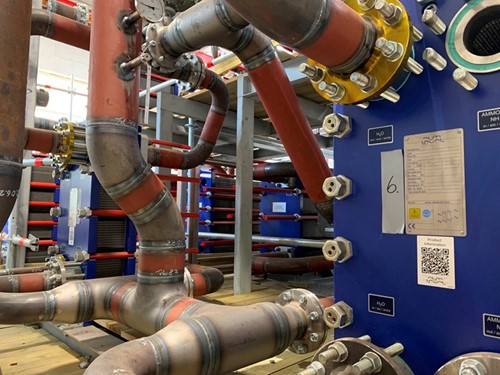Project
Roskilde's wastewater supplies heat to approx. 3,550 households

Project
A sector coupling project in Roskilde utilises heat in wastewater for district heating production. This is made possible with a new heat pump system, which benefits both the environment and every heat consumer’s wallet.
Most people don’t give a second thought to their wastewater after it disappears into the sewer and is led to the treatment plant. However, wastewater is not just waste. It is a high grade multi-resource from which, among other things, biogas, agricultural fertilisers and district heating can be produced.
For most of the year wastewater is warmer than both seawater and air. It is, therefore, an obvious heat source for a heat pump system that can produce district heating. Although there has been no technological revolution, the utilisation of wastewater in a heat pump system is a relatively new concept, and it is now starting to attract a lot of attention and gain popularity across Denmark.
In January 2019, the first plans for a wastewater heat pump located at Fors' treatment plant in Bjergmarken in Roskilde were put on the drawing board. In March 2021, the plant was delivered, with NIRAS as consultant on its development, all the way from start to finish.
The utility company Fors previously received all its heat from the VEKS' transmission network - except for local peak and reserve load produced at boiler plants that provide supplementary heat production during cold periods or in the event of failure of other production units. After installation of the new heat pump system, approx. 64,000 MWh / year is now supplied from the wastewater heat pump. This corresponds to approx. 15% of Fors Varme's total district heating supply.
households' annual heating needs are covered by heat from wastewater in Roskilde.
Fors Varme has long had challenges with high supply temperatures in several places in the district heating network. This is because the heat from VEKS' transmission network is supplied via heat exchangers in the eastern part of the district heating area, from where the heat must be distributed to the rest of the district heating distribution network. In order to maintain the required supply temperature for all their customers, in line with technical regulations, the temperature loss en route from the heat exchanger stations to customers must be compensated for. This is done by raising the supply temperature from the heat exchanger stations in the eastern part of the district heating area.
Fors' treatment plant on Bjergmarken is located in the western part of Roskilde. By establishing significant heat production in this part of Roskilde, the need for the high supply temperatures in the eastern part of the district heating network has been reduced. The result is both a lower heat loss throughout the network and reduced wear and tear on the pre-insulated pipes, which in turn is a benefit to both the environment and operating costs.
"Lowering the flow temperature throughout the district heating network, and thereby reducing heat loss is a fantastic economic and environmental side benefit of the project."
Christian Risborg, project manager
There is great focus in the utilities sector on sector coupling, where different types of utility co-operate and extract gains from unused resources in their respective sectors. Sector coupling provides an overall benefit to the climate, the environment and the corporate and social economy. A heat pump system that utilises wastewater as a heat source for district heating production is a good example of this. Here, two types of utility are working together on resource utilisation, resulting in significant financial gain in the form of lower heating prices. There are also gains for the environment and climate due to lower emissions of organic substances (BOD) to Roskilde Fjord and a lower CO₂ footprint for heat production.
Sector coupling is not merely a fashionable notion. It is a real and important element in the green transition and better resource utilisation in the circular economy. A project with a high degree of sectoral coupling like this has required interdisciplinary consultancy in interplay with many professional disciplines in order to successfully achieve its goals.
NIRAS is among the leading consultancies in the field and is responsible for, and has been responsible for, consultancy on several large heat pump systems that use wastewater as a heat source.

* Coefficient Of Performance (COP) indicates the ratio between the heat produced by the heat pump and the amount of power used in the heat pump.

